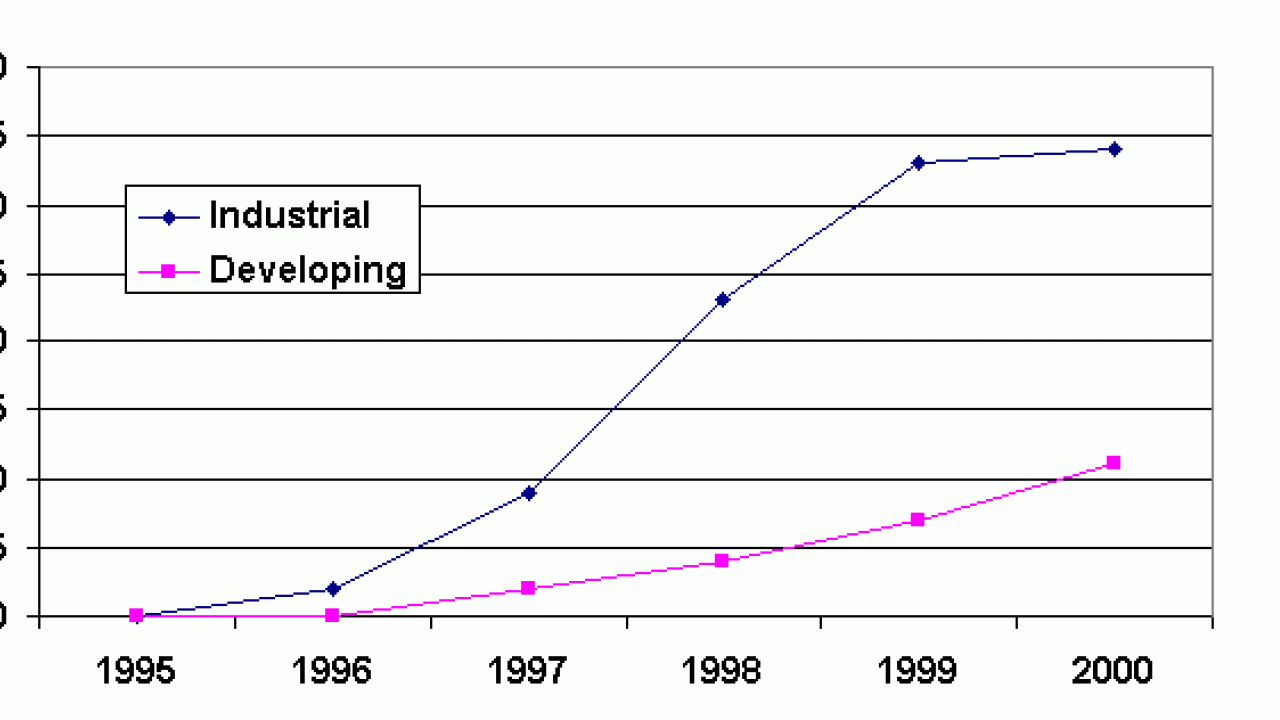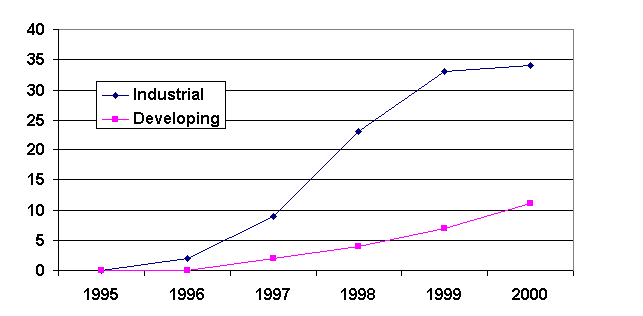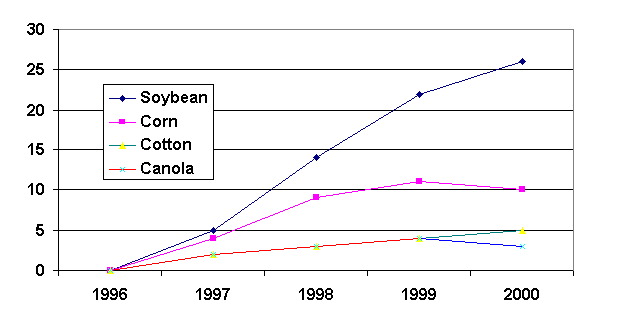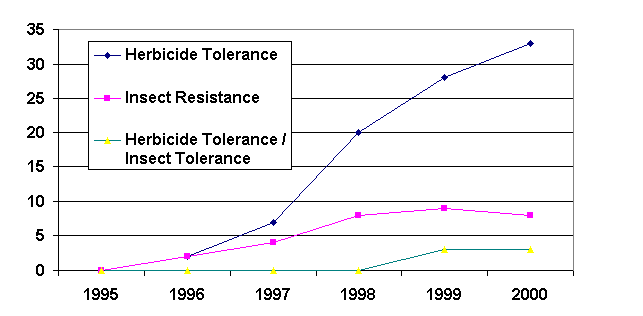
U.S. Farmers Are Rapidly Adopting Biotech Crops (Jan 1999)
Within the last few years farming of genetically modified crop varieties has dramatically increased in U.S. agriculture among crops such as corn, soybeans and cotton. Farmers have responded positively to this new technology. Since their commercial introduction only three years ago, acreage has soared to 50 million acres. These new crops feature resistance to pests and the ability to tolerate herbicides. The increased farming of these crops have been encouraged by the potential cost savings, including reductions in input use.
Development
The development of agricultural biotechnology has occurred in two stages. In the first stage, genetic modifications have included input traits such as pest resistance and herbicide tolerance, providing advantages to farmers in the production phase without changing the final product. The input traits of the first stages in genetically modified crops may increase farmers' net profits through savings in production costs, reducing chemical use, increased flexibility in crops planted, and in some cases, increased crop yield. The second stage of genetic modification will focus on output traits such as improved nutritional features and processing characteristics.
Currently
Genetically modified crops currently on the market are approved by the Food and Drug Administration (FDA), the Environmental Protection Agency (EPA), and USDA's Animal and Plant Health Inspection Service (APHIS) and are a result of very sizable investments, largely by private sector firms. Although the technology is generally available through many seed companies, farmers pay a premium price for the genetically modified seed. However, the genetically modified crops that are currently available have little or no impact on the prices the farmers pay. This is because these GM crops are basically no different from the conventional crops. With the development and the inclusion of output traits, crops will be significantly enhanced for the end-user having prominent effects on pricing and marketing.
Major Crops
Major new pest-resistant and herbicide-tolerant crops include oilseeds, corn and cotton. In 1996, the first year of commercial production, farmers harvested 1 million acres of genetically modified glyphosate-tolerant soybeans. By 1997, as seed became available in most producing regions, about 9 million acres were grown. U.S. farmers are expected to harvest more than 20 million acres this year, about 30 percent of total soybean acreage. In the year 2000 more than half of the soybean acreage could be planted to varieties with this gene. This technology is being enthusiastically implemented by world producers such as Argentina and Canada. Other oilseeds such as sunflowers, canola , and flax are also being genetically altered for herbicide tolerance. Although the seed is higher in cost, the cost is reportedly offset by a reduction in the input costs.
Resistance
Bt corn is designed to resist damage from the European corn borer (ECB), a major insect pest in the Corn Belt. The impact of this insect is not always seen until the damage has occurred because the borer tunnels inside the stalk. While Bt corn is resistant to specific groups of insects such as the corn borer, it has not been shown to have a direct effect on beneficial insects. Bt corn was first approved for sale in 1996. Sources from industry indicate that Bt corn could be planted on 15-18 million acres in 1998 (about 20 percent of U.S. corn acreage), up from less than 5 million acres in 1997. Results have been generally positive. Where infestation of borer insects were very heavy, yields of Bt corn in some areas were dramatically higher than non-Bt corn. The next major pest control feature will target rootworm. This technology will be introduced in the next 2 or 3 years, and market prospects look promising. Also in the works is development of disease resistant crops.
Herbicide-tolerant corn is on the market now, including varieties that tolerate popular herbicides based on glyphosate, glufosinate ammonium, and on imidazolinone. In 1998, seed herbicides is available for more than 7 million acres of imidazolinone corn, over 6 million acres of glufosinate ammonium corn, and 900,000 acres of glyphosate corn. Farmers have a more complicated response to herbicide-tolerant corn than for insect-resistant crops like Bt corn. Weed problems are more varied depending on both geography and time of year. The effectiveness of herbicide-tolerant corn will vary by region and by management practices.
Genetically modified cotton is also now available with herbicide-tolerant and insect-resistant traits. In 1996, a genetically engineered cotton called Bollgard became available to commercial farmers. A 1996 survey by Monsanto revealed that 80 percent of producers were satisfied with Bollgard cotton. The survey reported that U.S. growers using Bt varieties achieved a modest yield increase over non-Bt cotton and that there was a decline in the use of insecticides. Although overall insecticide use is expected to decline with Bt crops factors such as insect levels, seed varieties, weather, and other environmental conditions will continue to effect the performance of any genetically modified crop. For instance, in 1996 some Texas producers using Bt cotton where there was an unusually high insect infestation claimed losses of 18,000 acres due to cotton bollworm damage. As producers are beginning to understand, Bt cotton does not eliminate all necessary pest management practices and continued monitoring of insect activity is necessary.
Genetically modified cotton composed 13 percent of U.S. cotton acreage in 1996, about 1.9 million acres in 1997, about 25 percent of U.S. cotton acreage, approximately 3.4 million acres. Plans for the future are to develop additional tolerances of insects, diseases, and nematodes, and to incorporate genes designed to improve yield, harvestability, and drought and salt tolerance of cotton. Besides cost savings incentive to adopt any new technology is convenience. Pest-resistant crops can reduce management tasks while growers can simplify their herbicide use and often reduce the number of herbicide applications. So far, most of the new technology introduced has not been aimed specifically at increasing crop yields. However, some of the new corn products will effectively boost yields by decreasing losses to weeds or pests.
Impact of Use
Benefits of genetically modified crops will vary from year to year and over different locations depending on environmental factors. The environmental benefits of herbicide-tolerant crops derive from the reduction in the number of chemical applications, reduction in energy use due to fewer passes across the fields, and reduction in the need for tillage. Runoff of chemicals into groundwater could be minimized and no-till operations can reduce the erosion of top-soil.
Concerns
Concerns about insects have created a strong incentive for Bt seed selling companies to install certain production practices as part of a insect resistance management program. The Environmental Protection Agency (EPA) has developed a two-part pest management plan. First, the developing company must ensure that the Bt strains carry enough toxin to kill most feeding insects so that they cannot mate. Second, the developing companies must ensure that farmers plant nearby areas to a non-Bt variety to provide a refuge for survival of nonresistant insects. Companies are also prepared to tap different strains and versions of Bt to offer new generations of product. Growers also fear that weed species which are more susceptible to Bt crops will decline while stronger species of weeds build up eliminating the effectiveness of the crop. Further monitoring and research are needed over time to adequately address concerns about weed and insect resistance. Because agricultural biotechnology is so new, assessments of its effectiveness, cost and labor savings, yield advantages, and ecological impacts are limited.
Source: Agricultural Outlook. Aug. 1998. Riley, P.A., L. Hoffman, M. Ash. Economic Research Service. p21-24
Global Review of Commercialized Transgenic Crops: 2000
Introduction
Global population exceeded 6 Billion in 2000 and is expected to reach approximately 9 Billion by 2050. During the last five years, 1996 to 2000, global adoption rates for transgenic crops are unprecedented and reflect grower satisfaction with the products that offer significant benefits ranging from more convenient and flexible crop management, higher productivity or net returns per hectare and a safer environment through decreased use of conventional pesticides, which collectively contribute to a more sustainable agriculture.

Up to 85% of global transgenic crops have been grown in industrial countries, however the proportion of transgenic crops grown in developing countries has increased.

Biotech modified soybean is the dominant crop world wide, occupying 58% of the global area of transgenic crops in 2000. Transgenic corn area in 2000 is estimated to have decreased globally with the major decreases in the USA and in Canada. Some observers have indentified the principle cause of the decrease in transgenic corn in the US in 2000 to lower plantings of BT corn by farmers who conclude low infestation of European Corn Borer in 1999.

During the five-year period, 1996-2000, herbicide tolerance has consistently been the dominant trait with insect resistance being second.
Source: Global Review of Commericalized Transgenic Crops: 2000. by Clive James, Chair, ISAAA Board of Directors